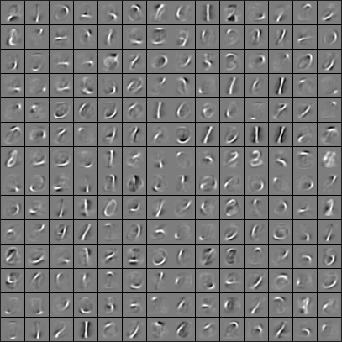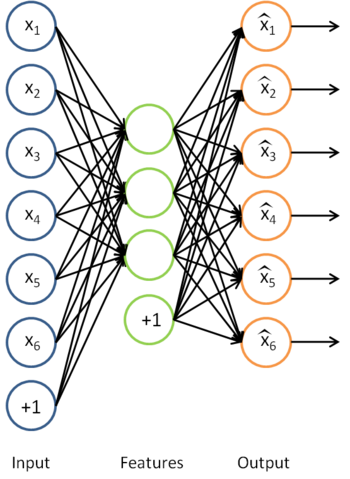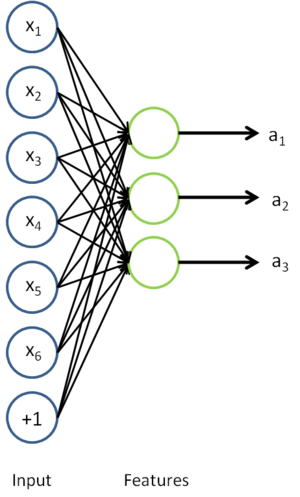CS229 6.11 Neurons Networks implements of self-taught learning
在machine learning領域,更多的資料往往強於更優秀的演算法,然而現實中的情況是一般人無法獲取大量的已標註資料,這時候可以通過無監督方法獲取大量的未標註資料,自學習( self-taught learning)與無監督特徵學習(unsupervised feature learning)就是這種演算法。雖然同等條件下有標註資料蘊含的資訊多於無標註資料,但是若能獲取大量的無標註資料並且計算機能夠加以利用,計算機往往可以取得比較良好的結果。
通過自學習與無監督特徵學習,可以得到大量的無標註資料,學習出較好的特徵描述,在嘗試解決一個具體的分類問題時,可以基於這些學習出的特徵描述和任意的(可能比較少的)已標註資料,使用有監督學習方法在標註資料上完成分類。
在擁有大量未標註資料和少量已標註資料的場景下,通過對所有x(i)進行特徵學習得到a(i),在標註資料中用a(i)替原始的輸入x(i)得到新的訓練樣本{a(i) ,y(i) }(i=1...m),即可取得很好的效果,即使在只有標註資料的情況下,本演算法依然能取得很好的效果。
autoencoder可以在無標註資料集中學習特徵,給定一個無標註的訓練資料集 (下標
(下標  代表“不帶類標”),首先進行預處理,比如pca或者白化,然後訓練一個sparse autoencoder:
代表“不帶類標”),首先進行預處理,比如pca或者白化,然後訓練一個sparse autoencoder:
通過訓練得到的模型引數  ,給定任意的輸入資料
,給定任意的輸入資料 
 。相比原始輸入
。相比原始輸入  來說,
來說, 可能是一個更好的特徵描述。下圖的神經網路描述了特徵(啟用量
可能是一個更好的特徵描述。下圖的神經網路描述了特徵(啟用量  )的計算:
)的計算:
對應之前所提到的,假定有  個 已標註訓練集
個 已標註訓練集  (下標
(下標  表示“帶類標”),現在可以為輸入資料找到更好的特徵描述。將
表示“帶類標”),現在可以為輸入資料找到更好的特徵描述。將  輸入到稀疏自編碼器,得到隱藏單元啟用量
輸入到稀疏自編碼器,得到隱藏單元啟用量  。接下來,可以直接使用
。接下來,可以直接使用  來代替原始資料
來代替原始資料  (“替代表示”,Replacement Representation)。也可以合二為一,使用新的向量
(“替代表示”,Replacement Representation)。也可以合二為一,使用新的向量 
 (“級聯表示”,Concatenation Representation)。
(“級聯表示”,Concatenation Representation)。
經過變換後,訓練集就變成  或者是
或者是 (取決於使用
(取決於使用  替換
替換  還是將二者合併)。在實踐中,將
還是將二者合併)。在實踐中,將  和
和  合併通常表現的更好。考慮到記憶體和計算的成本,也可以使用替換操作。
合併通常表現的更好。考慮到記憶體和計算的成本,也可以使用替換操作。
最終,可以訓練出一個有監督學習演算法(例如 svm, logistic regression 等),得到一個判別函式對  值進行預測。預測過程如下:給定一個測試樣本
值進行預測。預測過程如下:給定一個測試樣本  ,重複之前的過程,將其送入稀疏自編碼器,得到
,重複之前的過程,將其送入稀疏自編碼器,得到  。然後將
。然後將  (或者
(或者  )送入分類器中,得到預測值。
)送入分類器中,得到預測值。
從未標註訓練集  中學習這一過程中可能計算了各種資料預處理引數。例如計算資料均值並且對資料做均值標準化(mean normalization);或者對原始資料做主成分分析(PCA),然後將原始資料表示為
中學習這一過程中可能計算了各種資料預處理引數。例如計算資料均值並且對資料做均值標準化(mean normalization);或者對原始資料做主成分分析(PCA),然後將原始資料表示為  (又或者使用 PCA 白化或 ZCA 白化)。這樣的話,有必要將這些引數儲存起來,並且在後面的訓練和測試階段使用同樣的引數,以保證新來(測試)資料進入稀疏自編碼神經網路之前經過了同樣的變換。例如,如果對未標註資料集進行PCA預處理,就必須將得到的矩陣
(又或者使用 PCA 白化或 ZCA 白化)。這樣的話,有必要將這些引數儲存起來,並且在後面的訓練和測試階段使用同樣的引數,以保證新來(測試)資料進入稀疏自編碼神經網路之前經過了同樣的變換。例如,如果對未標註資料集進行PCA預處理,就必須將得到的矩陣  儲存起來,並且應用到有標註訓練集和測試集上;而不能使用有標註訓練集重新估計出一個不同的矩陣
儲存起來,並且應用到有標註訓練集和測試集上;而不能使用有標註訓練集重新估計出一個不同的矩陣  (也不能重新計算均值並做均值標準化),否則的話可能得到一個完全不一致的資料預處理操作,導致進入自編碼器的資料分佈迥異於訓練自編碼器時的資料分佈。
(也不能重新計算均值並做均值標準化),否則的話可能得到一個完全不一致的資料預處理操作,導致進入自編碼器的資料分佈迥異於訓練自編碼器時的資料分佈。
有兩種常見的無監督特徵學習方式,區別在於有什麼樣的未標註資料。自學習(self-taught learning) 是其中更為一般的、更強大的學習方式,它不要求未標註資料  和已標註資料
和已標註資料  來自同樣的分佈。另外一種帶限制性的方式也被稱為半監督學習,它要求
來自同樣的分佈。另外一種帶限制性的方式也被稱為半監督學習,它要求  和
和 服從同樣的分佈。下面通過例子解釋二者的區別。
服從同樣的分佈。下面通過例子解釋二者的區別。
假定有一個計算機視覺方面的任務,目標是區分汽車和摩托車影象;也即訓練樣本里面要麼是汽車的影象,要麼是摩托車的影象。哪裡可以獲取大量的未標註資料呢?最簡單的方式可能是從網際網路上下載一些隨機的影象資料集,在這些資料上訓練出一個稀疏自編碼器,從中得到有用的特徵。這個例子裡,未標註資料完全來自於一個和已標註資料不同的分佈(未標註資料集中,或許其中一些影象包含汽車或者摩托車,但是不是所有的影象都如此)。這種情形被稱為自學習。
相反,如果有大量的未標註影象資料,要麼是汽車影象,要麼是摩托車影象,僅僅是缺失了類標號(沒有標註每張圖片到底是汽車還是摩托車)。也可以用這些未標註資料來學習特徵。這種方式,即要求未標註樣本和帶標註樣本服從相同的分佈,有時候被稱為半監督學習。在實踐中,常常無法找到滿足這種要求的未標註資料(到哪裡找到一個每張影象不是汽車就是摩托車,只是丟失了類標號的影象資料庫?)因此,自學習在無標註資料集的特徵學習中應用更廣。
下面通過自學習的方法,整合sparse autoencoder 與 softmax regression 來構建一個手寫數字的分類。
演算法步驟:
1)把MNIST資料庫的資料分為labeled(0-4) 與 unlabeled(5-9),並且把labeled data 分為 test data 與 train data,一半用來測試,一般用來訓練
2)用unlabeled data (5-9)訓練一個 sparse autoencoder,得到所有引數W(1) W(2) b(1) b(2) ,記做 θ ,展示第一層引數W(1),展示效果如下:

3)使用上面的sparse autoencoder 訓練出來的W(1)對labeled data(0-4)訓練得到其隱層輸出a(2),這樣不適用原來的畫素值,而使用學到的特徵來對0-4進行分類。
4)用上述學到的特徵a(2)(i)代替原始輸入x(i),現在的樣本為{(a(1) ,y(1))(a(2) ,y(2))...(a(m) ,y(m))},用該樣本來訓練我們的softmax分類器。
5)用訓練好的softmax進行預測,在labeled data 中的 test data 進行測試即可。準確率講道理的話應該有98%以上。
一下是matlab程式碼。部分程式碼直接呼叫到之前章節的:

%% CS294A/CS294W Self-taught Learning Exercise % Instructions % ------------ % % This file contains code that helps you get started on the % self-taught learning. You will need to complete code in feedForwardAutoencoder.m % You will also need to have implemented sparseAutoencoderCost.m and % softmaxCost.m from previous exercises. % %% ====================================================================== % STEP 0: Here we provide the relevant parameters values that will % allow your sparse autoencoder to get good filters; you do not need to % change the parameters below. inputSize = 28 * 28; numLabels = 5; hiddenSize = 200; sparsityParam = 0.1; % desired average activation of the hidden units. % (This was denoted by the Greek alphabet rho, which looks like a lower-case "p", % in the lecture notes). lambda = 3e-3; % weight decay parameter beta = 3; % weight of sparsity penalty term maxIter = 400; %% ====================================================================== % STEP 1: Load data from the MNIST database % % This loads our training and test data from the MNIST database files. % We have sorted the data for you in this so that you will not have to % change it. % Load MNIST database files mnistData = loadMNISTImages('mnist/train-images-idx3-ubyte'); mnistLabels = loadMNISTLabels('mnist/train-labels-idx1-ubyte'); % Set Unlabeled Set (All Images) % Simulate a Labeled and Unlabeled set labeledSet = find(mnistLabels >= 0 & mnistLabels <= 4); unlabeledSet = find(mnistLabels >= 5); %把labeled set分為訓練資料 和 測試資料 numTrain = round(numel(labeledSet)/2); trainSet = labeledSet(1:numTrain); testSet = labeledSet(numTrain+1:end); unlabeledData = mnistData(:, unlabeledSet); trainData = mnistData(:, trainSet); trainLabels = mnistLabels(trainSet)' + 1; % Shift Labels 0-4 to the Range 1-5 testData = mnistData(:, testSet); testLabels = mnistLabels(testSet)' + 1; % Shift Labels 0-4 to the Range 1-5 % Output Some Statistics fprintf('# examples in unlabeled set: %d\n', size(unlabeledData, 2)); fprintf('# examples in supervised training set: %d\n\n', size(trainData, 2)); fprintf('# examples in supervised testing set: %d\n\n', size(testData, 2)); %% ====================================================================== % STEP 2: Train the sparse autoencoder % This trains the sparse autoencoder on the unlabeled training % images. % Randomly initialize the parameters theta = initializeParameters(hiddenSize, inputSize); %% ----------------- YOUR CODE HERE ---------------------- % Find opttheta by running the sparse autoencoder on % unlabeledTrainingImages %theta 現再是以個展開的向量,對應[W1,W2,b1,b2]的長向量 opttheta = theta; opttheta = theta; addpath minFunc/ options.Method = 'lbfgs'; options.maxIter = 400; options.display = 'on'; [opttheta, loss] = minFunc( @(p) sparseAutoencoderLoss(p, ... inputSize, hiddenSize, ... lambda, sparsityParam, ... beta, unlabeledData), ... theta, options); %% ----------------------------------------------------- % Visualize weights,展示W1'(28*28 * 200的矩陣) % 把該矩陣的每一列展示為一個28*28的圖片,來看效果 W1 = reshape(opttheta(1:hiddenSize * inputSize), hiddenSize, inputSize); display_network(W1'); %%====================================================================== %% STEP 3: Extract Features from the Supervised Dataset % % You need to complete the code in feedForwardAutoencoder.m so that the % following command will extract features from the data. trainFeatures = feedForwardAutoencoder(opttheta, hiddenSize, inputSize, ... trainData); testFeatures = feedForwardAutoencoder(opttheta, hiddenSize, inputSize, ... testData); %%====================================================================== %% STEP 4: Train the softmax classifier softmaxModel = struct; % Use softmaxTrain.m from the previous exercise to train a multi-class % classifier. % Use lambda = 1e-4 for the weight regularization for softmax % You need to compute softmaxModel using softmaxTrain on trainFeatures and % trainLabels lambda = 1e-4; inputSize = hiddenSize; numClasses = numel(unique(trainLabels));%unique為找出向量中的非重複元素並進行排序 options.maxIter = 100; %注意這裡的資料不是x^(i),而是a^(2). softmaxModel = softmaxTrain(inputSize, numClasses, lambda, ... trainFeatures, trainLabels, options); %% ----------------------------------------------------- %%====================================================================== %% STEP 5: Testing % Compute Predictions on the test set (testFeatures) using softmaxPredict % and softmaxModel [pred] = softmaxPredict(softmaxModel, testFeatures); %% ----------------------------------------------------- % Classification Score fprintf('Test Accuracy: %f%%\n', 100*mean(pred(:) == testLabels(:))); % (note that we shift the labels by 1, so that digit 0 now corresponds to % label 1) % % Accuracy is the proportion of correctly classified images % The results for our implementation was: % % Accuracy: 98.3% % % %%%%%%%%%%%%% 以下對應STEP 3,%%%%%%%%%%%%%% function [activation] = feedForwardAutoencoder(theta, hiddenSize, visibleSize, data) % theta: trained weights from the autoencoder % visibleSize: the number of input units (probably 64) % hiddenSize: the number of hidden units (probably 25) % data: Our matrix containing the training data as columns. So, data(:,i) is the i-th training example. % We first convert theta to the (W1, W2, b1, b2) matrix/vector format, so that this % follows the notation convention of the lecture notes. W1 = reshape(theta(1:hiddenSize*visibleSize), hiddenSize, visibleSize); b1 = theta(2*hiddenSize*visibleSize+1:2*hiddenSize*visibleSize+hiddenSize); %% ---------- YOUR CODE HERE -------------------------------------- % Instructions: Compute the activation of the hidden layer for the Sparse Autoencoder. %計算隱層輸出a^(2) activation = sigmoid(W1*data+repmat(b1,[1,size(data,2)])); %------------------------------------------------------------------- end %------------------------------------------------------------------- % Here's an implementation of the sigmoid function, which you may find useful % in your computation of the costs and the gradients. This inputs a (row or % column) vector (say (z1, z2, z3)) and returns (f(z1), f(z2), f(z3)). function sigm = sigmoid(x) sigm = 1 ./ (1 + exp(-x)); endView Code



